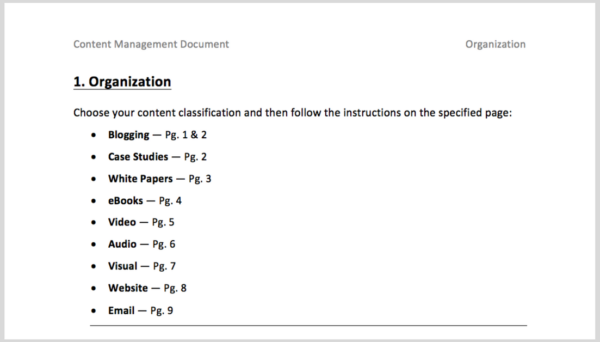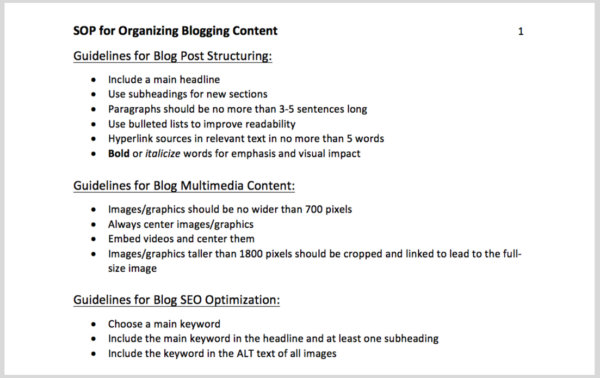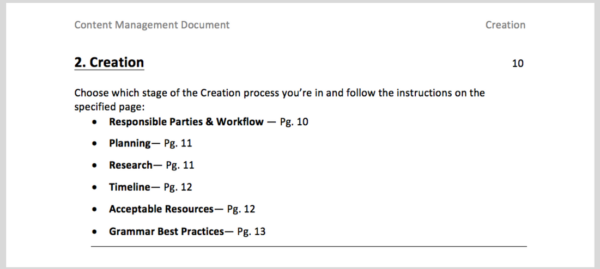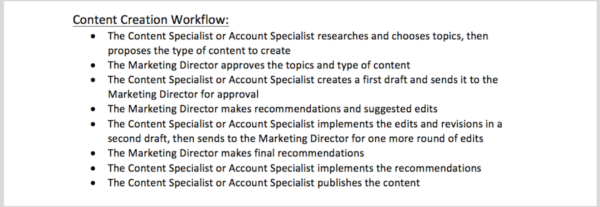Create content, they said. It’s the king of marketing, they said. Content is the best way to attract more website traffic and convert qualified leads, they said.
What they didn’t tell you? Content management is a whole other ball game and it can get messy.
According to Marketing Week, 60% of the content created by the world’s most powerful brands is clutter. That means that every day the internet is being flooded with wasteful, useless content.
Even worse?
All of the great content you create gets lost in a sea of mediocrity where it never has the opportunity to deliver value to your target audience.
The solution to this problem is focusing on content management and creating a process that streamlines the research, development, and implementation of branded content.
Getting Started with Content Management
Let’s start with the obvious. What is content management?
The process of creating, organizing, optimizing, and distributing all forms of content.
You might notice the emphasis on process. Content management is first and foremost a process that aims to improve efficiency and eliminate barriers to success.
Establishing a Content Management Process
Content management helps you systematically oversee and guide content from the first step of creation to the final step of archiving or updating. Understanding the role that content management plays in the digital content lifecycle is critical to developing your process.
Create a Content Distribution Strategy for 2018 that Delivers Maximum Impact
There are 6 stages of the content management lifecycle:
- Organization
- Creation and Workflow
- Storage
- Editing
- Publishing
- Removal or archiving (or updating)
Use these six stages to create an outline for a content management document. Your finalized document will help you keep track of all the content your brand creates and will inform where it gets published, how it’s distributed, and when you need to update or remove it from circulation.
The best way to develop your content management process is by thinking of it as a standard operating procedure (SOP) for your brand. There are 2 guiding principles to creating an effective content management process:
- Keep it simple
- Cover every aspect of content
Your process should be easy enough that a new hire can come in on day one and figure out how it operates. But, it also needs to be detailed enough to encompass every single aspect of the content process. From research and development to editing and publishing, your content management process needs to answer all questions and have a contingency for all scenarios.
Using a Content Management Document to Boost Efficiency
Before jumping into creating the content management document, here’s a general reminder that will save you a lot of hassle throughout the process: Make sure you only save and store a piece of content in one place to eliminate the chance of confusion and clutter.
Now that’s out of the way, let’s get started.
Your content management document will have 6 sections that mirror each step in the content management lifecycle:
1. Organization
Organization will help you keep track of your content throughout the entire digital content lifecycle. Start by creating categories that will help you classify content.
- For example: If blogging is a big part of your brand’s marketing strategy, you need to have a section of your content management document that describes how blog content will be organized.
The key is to be specific and create an SOP that is easy to follow and streamlines the process. You want everything to be organized as simply as possible so you can quickly retrieve content when it’s needed.
Another important aspect of this stage is planning for content that will be created later. Part of your content management SOP should also cover where ideas for future content will be organized for easy access. Be sure to have a spreadsheet—one that’s easily accessed by your team—called Content Ideas, where an ongoing list of new blog topics can be cultivated.
Here’s what the Organization section of your content management document could look like:
If you were going to navigate to the Blogging portion you’d go to page 1 of the Organization section of your content management document:
From there, anyone in your organization should be able to read through the entire section and efficiently execute each element of your blogging guidelines.
2. Creation and Workflow
This is where the magic happens. The content magic, that is. All the writing, design, brainstorming, and research happens in the creation stage. Since you’re making an SOP, it’s time to list out the best practices for each step in the content creation process.
Here are some questions you’ll need to answer in your process document:
- Who is responsible for creating the content?
- How long should it take to create the first draft?
- What resources can be used?
- What are your brand’s grammar best practices?
The list goes on. You want to cover enough information to make the creation process simple and effective, but not so much that content creators get bogged down in processes and lose their creative influence.
Here’s what the Creation section could look like:
If you were looking to see who was responsible for approving content, you would navigate to page 10 of the Creation section of your content management document:
Now you have access to all the information you need to implement the process for creating content, including who is responsible for content approval.
The Workflow portion of this section is where you’ll outline the content process from beginning to end. For example, if you were creating a workflow for blogging it might look something like this:
Basically, you want to establish a hierarchy for how your content proceeds through the lifecycle.
3. Storage
The storage section of your document should provide a naming convention for all your brand’s content and should dictate where each piece of content will be stored. For example, all blog posts could be named following this convention:
[date]_[blog-title]_[status]
or
01.22.18_How-to-Organize-Your-Content_Published
Once a blog post has been created and named, your SOP document should dictate where each blog post will be stored:
For example, start by creating a main folder called Blogging. Inside that folder would be a variety of folders marked by year—say, Blogging 2018—with subfolders inside for Guest Blogging, Native Blogging, Blog Post Images, and more.
Make sure to factor accessibility into your decision. If only one person owns the content creation and storage process, it might be difficult for other members of the team to access the content when it’s needed. Unless, of course, you have it documented like the rockstar marketers we know you are!
(Psst: if you’re not sure what type of content management tools are out there–we have a list in this very blog!)
4. Editing
Maintaining a consistent level of high-quality content requires several iterations of each piece of content. That’s where documenting your editing process comes into play.
Make sure you follow the same grammar and formatting practices that are used in the Creation portion of your document. Typically, this process should include a copy editor who is intimately familiar with your brand style guide and can ensure that edits are staying true to the brand identity.
You need to detail the steps that are involved in the editing process and dictate where and how each version will be managed. Fortunately, you’ve already created the workflow for content edits in the previous step. Now you just need to:
- Document how each new version will be created
- Document how edits will be tracked and implemented
- Detail the tools or guidelines that should be used during the editing process
This section of your content management document is a simple step that needs to be handled with precision. You don’t want to miscommunicate your editing guidelines and wind up with content that’s only half optimized, or worse, off-brand.
5. Publishing
The publishing portion of your content management document is one of the most important because this is where your content becomes visible to your prospects, leads, customers, and clients.
Document every step in the publishing process, and make sure you have individual requirements for each type of content—blogs and articles, videos, infographics, webinars, and more.
For example, if you were to create guidelines for publishing a blog in the WordPress dashboard, it could look something like this:
- Navigate to the WordPress dashboard and click “New Post” in the “Posts” drop-down menu
- Place the title of the approved blog post, along with the body content, into the WordPress editor
- Choose a relevant category for the blog post—no more than 3 categories should be selected
- Choose between 2-5 relevant tags—one should be an exact match of your main keyword phrase
- Turn section headings into H2 and H3 tags
- Optimize all images in the body of the blog post—include the main keyword in the ALT text
- Fill in the information for the Yoast SEO plugin—write the SEO title and Meta description, shorten the URL to include the main keyword, and add the main keyword to the provided slot
- Add a featured image that includes the main keyword as ALT text
The more detailed you are, the better. Leave as little room for error as possible.
6. Removal or Archiving (or Updating)
Most resources conclude with “removal or archiving” as the final step in the content lifecycle. But, updating your old content is another step that can generate excellent results.
Let’s review the signs to look for that indicate it’s time to remove or archive content, as well as the signs that it’s time to update your older content.
How to know when to remove or archive older content:
- If the content no longer reflects your current brand image
- If the content’s performance has been appalling
- If the content is out of date or ineffective
How to know when to update older content:
- When it still achieves decent reach and earns moderate engagement
- When the message still adds value for your audience
- When the research can be updated to improve value
Anytime you have the chance salvage older content and revamp it, you should. It takes far less time to update older content than it does to start from scratch on a new piece. Updating older content also gives you the chance to create pieces of evergreen content that never lose their usefulness. A high-quality piece of evergreen content can attract a large volume of traffic for many, many years.
Creating a document that covers all seven steps of the content lifecycle will allow you and your team work more efficiently by following an SOP for all aspects of content management.
Content Management Tools
Tools are a vital part of managing your content process. They can save you time, money, and the hassle of manually tracking down files.
Here’s a list of some of the best content management software systems and tools with brief descriptions of their uses and benefits:
WordPress
The overpowering leader in web hosting, “WordPress powers 29% of the internet.” The great thing about WordPress being so massive is there’s an almost endless supply of plugins that provide a variety of ways to display and utilize your content.
HubSpot
HubSpot is a fully integrated content management system (CMS) that combines the ability to manage blogs, social media channels, emails, landing pages, files, and more in one spot.
Known as one of the pioneers of Inbound Marketing, HubSpot is ideal for businesses that want to minimize the number of content management tools they’re using.
Box
Designed to allow businesses to easily store and share files, Box is a cloud-based content management system that allows for remote collaboration.
Asana
Self-described as “the easiest way to manage team projects and tasks,” Asana creates a visual display of work tasks that can be organized by client, project, and much more.
It’s important to note that there are many, many other content management tools available—Google Drive, Drupal, Microsoft Teams, and SharePoint, to mention a few. It usually takes years of testing, trial and error, and experimentation to find the tools and programs that will meet your company’s needs.
Discovering Your Content Management Solutions
The key to finding a content management solution for your brand is to document your process. Once your process is documented you’ll be able to identify all the areas that can be improved with the assistance of tools or software and address them accordingly.
Just remember to start by building a documented process that addresses each of the six stages of the content management lifecycle. Be thorough and focus on covering each step with a simple approach that can be implemented by a new hire on day one.
Read more:









